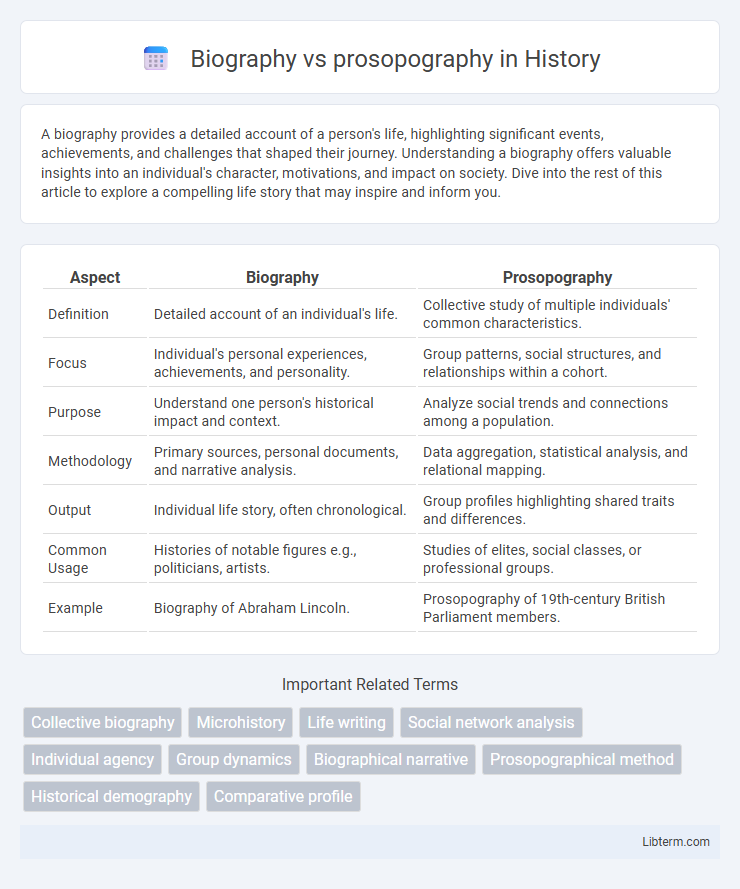A biography provides a detailed account of a person's life, highlighting significant events, achievements, and challenges that shaped their journey. Understanding a biography offers valuable insights into an individual's character, motivations, and impact on society. Dive into the rest of this article to explore a compelling life story that may inspire and inform you.
Table of Comparison
| Aspect | Biography | Prosopography |
|---|---|---|
| Definition | Detailed account of an individual's life. | Collective study of multiple individuals' common characteristics. |
| Focus | Individual's personal experiences, achievements, and personality. | Group patterns, social structures, and relationships within a cohort. |
| Purpose | Understand one person's historical impact and context. | Analyze social trends and connections among a population. |
| Methodology | Primary sources, personal documents, and narrative analysis. | Data aggregation, statistical analysis, and relational mapping. |
| Output | Individual life story, often chronological. | Group profiles highlighting shared traits and differences. |
| Common Usage | Histories of notable figures e.g., politicians, artists. | Studies of elites, social classes, or professional groups. |
| Example | Biography of Abraham Lincoln. | Prosopography of 19th-century British Parliament members. |
Defining Biography and Prosopography
Biography provides a detailed, narrative account of an individual's life, emphasizing personal experiences, achievements, and chronological events. Prosopography systematically examines common characteristics of a historical group through collective biographies, focusing on patterns and social structures rather than singular life stories. Both methodologies contribute uniquely to historical research, with biography highlighting individual agency and prosopography revealing broader societal trends.
Historical Development of Each Approach
Biography emerged as a distinct historical approach during the Renaissance, emphasizing individual lives to illustrate broader cultural and moral themes, while prosopography developed in the 19th and 20th centuries as a systematic method to analyze collective characteristics of historical groups using quantitative data. The historical development of biography focused on narrative storytelling and personal achievements, contrasting with prosopography's analytical framework, which seeks patterns and social structures within groups. This differentiation highlights biography's role in emphasizing unique individual experiences versus prosopography's approach to understanding historical dynamics through data aggregation.
Key Differences Between Biography and Prosopography
Biography offers an in-depth, narrative account centered on an individual's life, highlighting personal experiences, achievements, and character traits. Prosopography systematically studies a group of people, emphasizing collective characteristics, social connections, and historical patterns. The key difference lies in biography's individual focus versus prosopography's collective analysis to understand broader social dynamics.
Typical Methodologies Employed
Biography typically employs in-depth qualitative methodologies, including primary source analysis, personal interviews, and archival research to construct a detailed narrative of an individual's life. Prosopography utilizes systematic data collection and quantitative techniques to analyze collective characteristics and social patterns across a group, often involving databases and statistical tools. Both approaches emphasize contextualizing subjects within historical frameworks but differ in scope and methodological focus.
Sources and Data Used in Research
Biography relies heavily on primary sources such as personal letters, diaries, interviews, and official records to construct an in-depth narrative of an individual's life. Prosopography, in contrast, uses collective data drawn from a variety of sources including census records, legal documents, genealogical databases, and institutional archives to analyze common characteristics within a group. While biography emphasizes detailed personal details, prosopography prioritizes aggregated data to uncover patterns and social structures.
Strengths and Limitations of Biography
Biography offers an in-depth, personalized account of an individual's life, providing rich, detailed insights into their motivations, experiences, and impact. Its strength lies in capturing the unique complexity of a single subject, making it ideal for understanding historical figures or influential personalities. However, biography's limitation is its narrow focus, which risks lack of broader context and potential bias, making it less effective for analyzing patterns or social trends across multiple individuals compared to prosopography.
Strengths and Limitations of Prosopography
Prosopography excels in revealing collective patterns and social structures by analyzing common characteristics of historical groups, which individual biographies often overlook. Its strength lies in providing quantitative data and broader context, but it may sacrifice personal detail and depth, limiting understanding of singular life experiences. Despite this, prosopography is invaluable for uncovering relationships and societal trends across time periods.
Applications in Historical Studies
Biography provides detailed individual life narratives, essential for understanding personal motivations and contributions within historical contexts. Prosopography collects and analyzes collective data on groups, revealing social structures, networks, and patterns across periods or communities. Historians apply both methods to balance micro-level individual insights with macro-level social trends for comprehensive historical analysis.
Examples of Notable Works in Both Fields
Biography includes notable works such as "The Life of Samuel Johnson" by James Boswell, which offers an in-depth narrative of a single individual's life, while prosopography features studies like "The Prosopography of the Later Roman Empire," a collective examination of individuals within a historical period. Biographies focus on detailed personal stories, whereas prosopographies analyze patterns and relationships among groups, exemplified by "The Anglo-Saxon Chronicle" in prosopographical form to understand societal structures. Both fields contribute to historical knowledge by balancing individual life stories with wider social contexts.
Choosing the Right Approach for Your Research
When choosing between biography and prosopography for research, consider whether the focus is on an in-depth analysis of a single individual's life or the collective study of a group with shared characteristics. Biography provides detailed, narrative insights into one person's experiences and influence, while prosopography reveals patterns, relationships, and social structures within groups by analyzing multiple subjects simultaneously. Selecting the appropriate approach depends on research goals, data availability, and the desired scope, with prosopography often benefiting historical sociology and biography excelling in personalized historical accounts.
Biography Infographic

 libterm.com
libterm.com